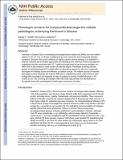Phenotypic screens for compounds that target the cellular pathologies underlying Parkinson's disease
Author(s)
Tardiff, Daniel F.; Lindquist, Susan
DownloadLindquist_Phenotypic screens.pdf (703.5Kb)
PUBLISHER_CC
Publisher with Creative Commons License
Creative Commons Attribution
Terms of use
Metadata
Show full item recordAbstract
Parkinson's disease (PD) is a devastating neurodegenerative disease that affects over one million patients in the US. Yet, no disease modifying drugs exist, only those that temporarily alleviate symptoms. Because of its poorly defined and highly complex disease etiology, it is essential to embrace unbiased and innovative approaches for identifying new chemical entities that target the underlying toxicities associated with PD. Traditional target-based drug discovery paradigm can suffer from a bias toward a small number of potential targets. Phenotypic screening of both genetic and pharmacological PD models offers an alternative approach to discover compounds that target the initiating causes and effectors of cellular toxicity. The relative paucity of reported phenotypic screens illustrates the intrinsic difficulty in establishing model systems that are both biologically meaningful and adaptable to high-throughput screening. Parallel advances in PD models and in vivo screening technologies will help create opportunities for identifying new therapeutic leads with unanticipated, breakthrough mechanisms of action.
Date issued
2012-03Department
Massachusetts Institute of Technology. Department of Biology; Whitehead Institute for Biomedical ResearchJournal
Drug Discovery Today: Technologies
Publisher
Elsevier
Citation
Tardiff, Daniel F., and Susan Lindquist. “Phenotypic Screens for Compounds That Target the Cellular Pathologies Underlying Parkinson’s Disease.” Drug Discovery Today: Technologies 10, no. 1 (March 2013): e121–e128.
Version: Final published version
ISSN
17406749